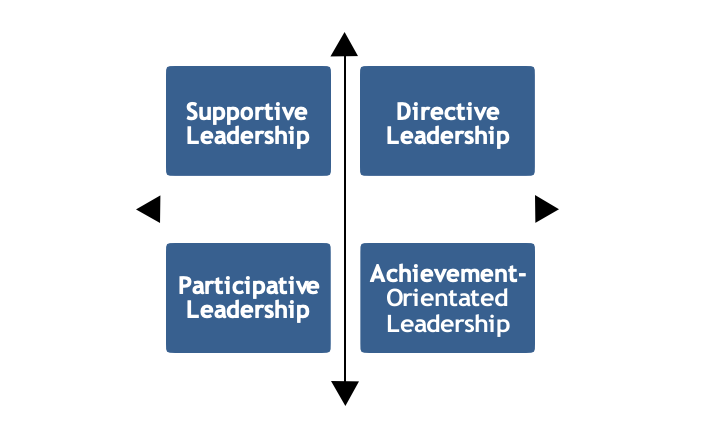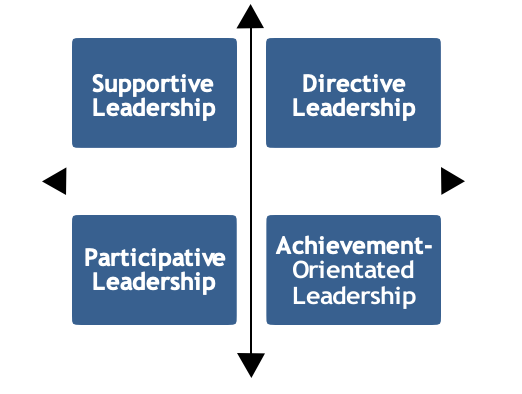Textbook Reading: Team FME - Path-Goal Theory
Any time there is a leader being placed in charge of a team, it is a safe bet that there is a goal or an objective at stake. Whether than goal is short-term, such as creating a new product that will launch in three months, or longer term like developing a branding strategy over the next five years, the goal is out there to be reached. Without goals, teams would have no target to direct their activities and productivity would be almost impossible to achieve.
At the same time, there is a path that leads the way to those goals. It might help to think of the path as the day-to-day reality of the process that is needed to reach the goal. Inevitably there will be roadblocks along this path—some small, and some large—so team members will need to be creative and agile in order to get around the blocks and stay on course to reach the target.

But what role does the leader play in this process? Trying to help a leader define their place in this equation so that they can give the team they manage the support they need without getting in the way.
Striking the right balance between supportive and intrusive is a difficult thing to do. That is what the Path-Goal Theory is all about and was developed by Robert House in the early ‘70’s. He presented three different responsibilities that leaders take on throughout a project.
Clearing the path. Basically, this refers to the process of helping see the way from the start to the finish. While the end goal might be clearly defined, the midpoints that need to be reached in order to arrive at the end successfully might be a little harder to identify. An experienced leader should be able to help his or her team figure out the best path to reach the goals that they are charged with. Frustration is quick to set in among team members when they can’t figure out which direction to head, so taking command at this point of the process is a sign of strong leadership


1. Removing obstacles. Rare is the project that doesn’t run into difficulties along the way. When the team is confronted with challenges that they aren’t immediately able to resolve, the leader may need to step in and take control of the situation. This could be as simple as providing the team with resources that they need to solve a problem, such as adding a new team member that brings a specific skill to the group.
In order to make sure a project stays on schedule and is completed successfully, a leader will want to watch out for major roadblocks standing in the way of the team.
2. Offering rewards. Motivation is a big part of success in any endeavor, but especially in ones that take place over long periods of time. Making sure that the individual members of the team are properly motivated and excited to work on the project is as important as anything else that takes place.
Whatever kind of motivation that a leader can offer—usually financial, but also including time off or other perks—can serve to maintain morale among the group and keep them charging ahead toward a successful conclusion.
In order to achieve those three objectives above, the Path-Goal Theory highlights four different styles of leadership that could be used. Naturally, it is up to the team leader to determine which of these styles—or what kind of blend—will be best to get the team from the start of the project to the finish.

● Supportive leadership—represents a setting in which the leader is working to
build relationships with the individual people on the team. Showing an interest in each individual as a person is a highlight of this method, which is important in terms of keeping morale high. A supportive leader likely already knows that the team members are capable of getting the job done, so they focus their efforts instead of managing relationships.
● Directive leadership—is evident in situations where the leader acts more like a dictator in terms of simply passing out assignments and objectives. Normally this kind of leading is done when the members of the team lack the needed experience
to work more autonomously. Instead, they must be guided by hand throughout the process, so the leader takes a more powerful role right from the start.
● Participative leadership—is where the leader treats the members of the team more as equals than as subordinates. The team members’ will likely feel empowered by this approach and it should spur them on to stay motivate and strive for success
throughout the project. Their opinions will be valued and listed to by the leader, who will act more as a member of the team than a dictator of the group.
● Achievement-oriented leadership—the leader lays out opportunities along the path for team members feel rewarded and their accomplishments recognized as they drive towards completion. This is really only a viable option when the team
is made up of experienced workers who don’t need any guidance or assistance in order to get the job done right. When a leader notices that morale and motivation are lagging in the group, this style might be just the right fix.
The Path-Goal Theory lays out a clear method for getting a team from the start of a project to the finish. With the three responsibilities understood, and the four different styles of leadership in hand, the manager can set to work making sure their team has everything they need to complete the objective as required.
Key Points
v" This theory presents three different responsibilities that leaders take on throughout a project, including clearing the path, removing obstacles and offering rewards.
v" Clearing the path refers to the process of helping the team to produce a roadmap for the project.
v" Removing obstacles means that when the team is confronted with challenges that they aren’t immediately able to resolve, the leader may need to step in and take control of the situation.
v" Offering rewards involves making sure that the individual members of the team are properly motivated to work on the project.
v" Path-Goal Theory highlights four different styles of leadership that could be used to achieve the above objectives.
